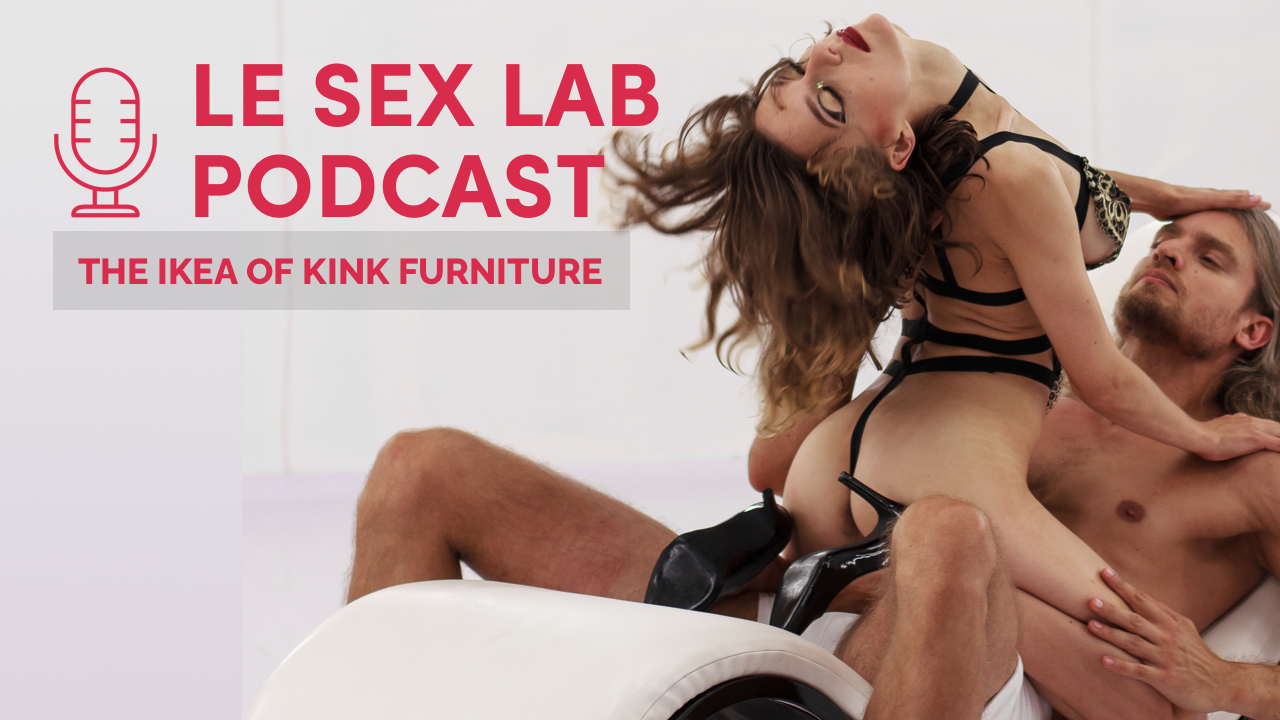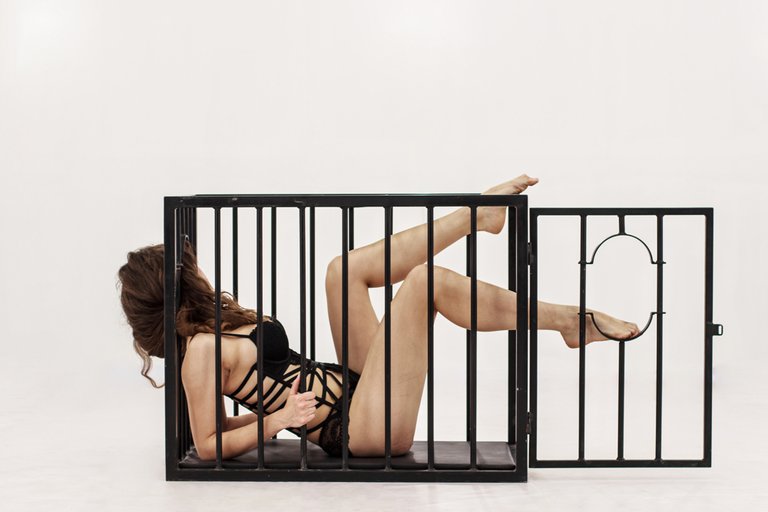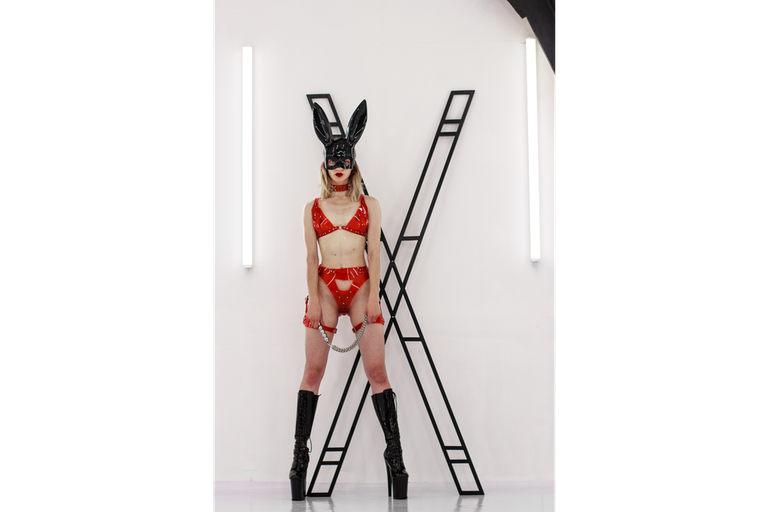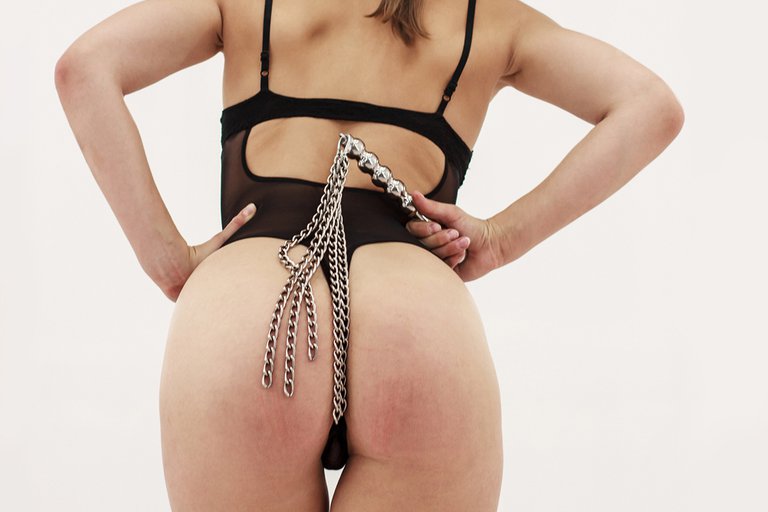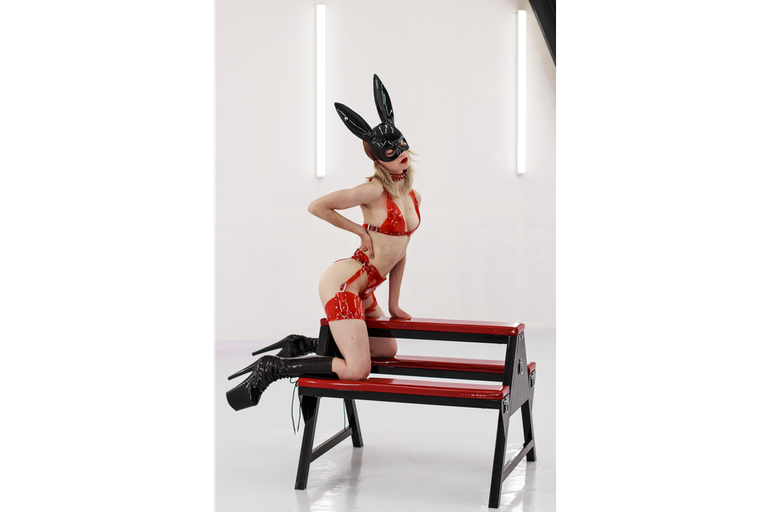The IKEA of Kink Furniture
By: Abby DivDate: April 5, 2021
In Le Sex Lab's podcast, we are talking about the Ikea of kink furniture. In the lab to talk about their custom design, kinky photography sessions, and creative partnerships are Founders of BDSM Architecture, Sally and Edgar.
Abigail Div
Hello everyone, we're going to be talking today about designing and shooting the IKEA of kink furniture. I'm your host, Abigail Div Founder of Le Sex Lab, an experimental media lab exploring sexuality and creative as podcast featuring media creators and innovators. In today's interview, we'll explore the following. How did BDSM architecture start? What's the design process, fashion function? Or maybe both? How do you produce shoots for the kinky home? And lastly, how do furniture designers keep themselves creatively inspired? With me today to talk about the creation of their fetish furniture Sally and Edgar, Founders of BDSM architecture. Welcome Sally and Edgar.
Sally
Hello.
Edgar
Hi.
Abigail Div
Hi, both. Welcome to Le Sex Lab's podcast.
Sally
We are happy to be here. Thank you very much for inviting.
Abigail Div
Oh, you're most welcome and you two design and build rather large pieces of furniture and sometimes very short timelines in as fast as four weeks to turn around from order to shipment. That's no small feat since your furniture ranges from almost six feet long sex chairs and seven feet long portable crosses about those probably take a little bit longer to build. But first, how did you get started? You're based in Lithuania correct?
Sally
Yes, we are based in Vilnius, Lithuania and we are both had a kinky background ourselves. We are from the BDSM community where we actually met, Edgar was unable to find what he truly wanted in the market. And in 2016, he built his first bench and cross by himself to use and enjoy local community once they were introduced to some of his work seem to like this multifunctionality and the designers sat cross and that bench he built so soon we met in the community as I mentioned before, and I joined the creative process. community was asking to make some pieces for them as well. And we think the interest of others became inspired to design, build and sell professionally made into furniture. We understood that together with a professional team, we are able to not only realize our own fantasies, but also make the dream come true for those who are interested in taking the lifestyle and are looking for something out of the ordinary to complete their life. Soon enough, we saw the opportunity to provide other people not as close friends. So we open the Etsy shop and launch our BDSM architecture website following soon after.
Abigail Div
Oh, how interesting. So what role did you play in actually building the pieces?
Edgar
At the very beginning, I was everything and welder, a carpenter and the level crafter by myself, as well as the sales and marketing manager and everything else. Just later, when I met Sally and we started selling on Etsy, we decided to grow up our team and share tests and make the process more efficient.
Abigail Div
Fascinating, but the name is BDSM architecture, not design or furniture, for instance, why?
Edgar
I have a civil engineer degree and a work in construction business at the time. So somehow architecture seems very close to me. We follow the basic architecture rules. structure has to be aesthetically beautiful, comfortable, reliable, not expensive and practical.
Abigail Div
Great. Let's talk more about the design then. The number of crafts that are required to execute one of your designs require a series of very specialized tools and techniques. With backgrounds Edgar, in engineering and Saleen entertainment, you do a lot, but I can't imagine you do everything. How many people are involved?
Sally
It depends on how you count. But currently we are working with about seven to 10 different people. We have a designer who puts our ideas to 3d models. We have engineer who creates detailed technical blueprints. We have two welding teams, we have a carpet and upholstery craftsmen. And we can also count on our creative team after production, photographers, stylists, makeup artist, and many more.
Abigail Div
It sounds like a boatload of talent all together to make one piece but how did you find your partners? Is that every day of course that you find somebody to well the cage.
Sally
Yeah, sure. So I'm talking about technical team. We just search partners on the internet as any other person would search for any other servers. We encounter companies who refuse to work with us sometimes when they see what the product is, and others are more than happy to create something special instead of building hundreds of fences for example. And most of our creative team appears accidentally in our path through community or calm On acquaintances
Abigail Div
Fascinating, and I can only imagine what sort of hurdles that you end up coming across in the process of trying to explain your design and concepts. But what exactly is it that you go through in terms of your process and design to conception,
Edgar
Usually the process starts with the need of some kind of functionality. For example, someone needs a personal restraint in this exact position with access to their private parts, when you look for inspiration on the market, or in the porn as well. And when we're in write down all the ideas with examples to our designer, he creates from three to five different 3d model designs from which we choose. Then we test measurements at home trying to recreate the necessary position to handle precise measurements as possible, and send everything to our engineer who draws technical blueprints. Only when we start manufacturing the prototype?
Abigail Div
Do you 'test' your prototypes?
Edgar
Of course we do. When we haven't finished an item, we test ourselves to check if everything is comfortable, and also right as we do strive to make universal items, that it would be suitable for people for all shapes and sizes. Will you give new prototypes to our local community, and friends to test it as well? Or bring it to our local parties so that as many people could try it as possible? We think on the best version of the item, sometimes we even catch ourselves in the middle of the fetish play, asking people questions, sometimes we even ask is your arm comfortable if it will be five centimeters higher? After we gather all necessary information, we send remarks to our engineer back to the raw imperfect parts. And then we make the new version to only after when we have a perfect version, we make a photograph of it and put it for sale. Sometimes this process takes two weeks, sometimes it can get up to seven months to create something really special.
Abigail Div
It is definitely a design process. And that is in in effect here from doing the initial prototyping to r&d with like, you know, friends and and your fetish community collaborators, if you will. So does the vision always translate to reality?
Edgar
Mostly yes, but we had some ideas that we created and it wasn't what we really expected. It is also very strange, but sometimes we are creating a new thing and we expect it to be our best seller. But finally no one is interested in it. On the other hand, sometimes we get some strange customer requests, which we could never expect to be popular. But when we have put it on the market, it becomes very popular.
Abigail Div
Is is one of those moments of artistic inspiration versus the reality check of what actually is is sellable, what people actually want to use and buy. Some of the things that are the most eccentric can be the some of the things that are the most popular and vice versa. You know, things that you think are going to be easy cells can be the most challenging things you know, from like the whips and the floggers, which you think are really easy, but it's a saturated market for whips and floggers. And there's a lot of people who sell them versus a sex chair where you are one of only a few sellers of an item. And the more eccentric it gets, the more inspiring it gets for people to buy it as well. But speaking of eccentricities, there is this common debate of you know, fashion versus function or aesthetics versus the functionality of a lot of BDSM and kink pieces. What is the purpose of your items?
Sally
The main purpose of the items are functionality, we do really strive at each piece would be easy to use and comfortable to implement its main function as both our from kinking community ourselves, we thoroughly test every item to make sure it's comfortable and functioning as it should be. And only then we come to the design so the item could not only be functioning but also stylish as well. As everything we made is easily this assemble without any special tools to flat panels. It's convenient to store the parts discreetly in a box under the bed or even in the corner or the wardrobe.
Abigail Div
I think for a lot of city dwellers is particularly apropos because you don't have the space to be able to make a full room dedicated to your sex play. A lot of it is cross functional. You need to be able to sleep in the bed as well as use the bed to have sex and you can't have two beds. And so it goes also with any other piece of large furniture it has to be something that's easy to store, but also can fit into your living decor without creating havoc or unnecessary tension, if you will to it as well. But let's discuss getting into the shooting of the actual products. You have full line of cages in multiple sizes and dimensions. You have rigging stands benches, I could go on and on with all the accessories that you have as well. As you're pairing both aesthetics and the functional element together, there's a dual purpose to all the images then you create as well. Let's say you're shooting a product, though, for the first time. What does a shoot look like?
Edgar
Firstly, we do a simple product shoot for a webshop a product itself in a white background and few shoots with a model to show them functionality and size reference. And later, when we hit when we have more products, we plan creative shoots, which represents some kind of idea or sends a message.
Abigail Div
And I see based on the wide variety of photography collaborations that you are truly artistically inspired by what you're doing. How do you find your collaborators? I see you're working with a Ukrainian photographer who name is Mariia Krasnykh. I'm just going to I'm sorry, if I just slaughtered her name.
Sally
Yes, we worked with Mariia. And I won't even try to spell her surname. So we usually use two different search methods. The one is simple, where we just browse the internet and try to find a photographer whose style we like. And the other is when we find common acquaintances or people from the community who are interested in creating something special. One of our recent photographers we started to work is Mariia, which you mentioned, she's originally from Ukraine, but she lives in Vilnius now. And she has a perfect eye from composition, our vibes concidered. And we found out that we don't need to search anyone else. Of course, we never see no for new photographers who want to have a collaboration with us. So if you're a photographer, and you are listening for us right now, please contact us, we are always open for nice creative ideas together.
Abigail Div
I think certainly having the creative vibe, as you say, Sally to making the inspiration into something that visually appeals to both eyes is a salient point for both photographer and designer, because you may not have the same vision. And ultimately, you're selling a product. So you want to make sure that both visions are synchronized, and that you're not compromising where you don't want to compromise especially on a branding perspective. But at the same time also with your collaborators and photographer friends, that they are also not feeling like their vision is being not seen fully. Because they also have an artistic eye for what they're doing. But speaking of photographers, the other half of the equation is the models of course, and you have some very interesting models in your product photography. They're not the tip of five, six foot two fashion model. How do you find your models?
Edgar
We do care with our models feel safe and comfortable during the shots. So we never take models from a common agencies, as not everyone agrees to represent BDSM stuff, they don't want to link them. So to be seen. Most of our models are from local Kin Community are models who pose nude art, sometimes photograph is offer via trusted models. Sometimes even girls contact us through Instagram, and express their will to be photographed. As they found our work fascinating.
Abigail Div
Yeah it's a very specific aesthetic, that I think it has to appeal to the person who is shooting it of course at some level as you are representing a BDSM brand. And your photos also offer a very sexy, sexual visuals and sometimes even mimic acts of having sex. But what actually happens during a shoot, like let's be real?
Edgar
We could separate two types of photoshoots here. First one is professional shoots for a web shop or collaborations, we have a very professional point of view. And as mentioned before, we do care with people that we work with would feel comfortable and relaxed during the scene. Nothing happens in this common shots. And it would be very unrespectful in so many ways. The second type is creative fetish play parties, where we are doing a fetish play where people meet and are willing to be photographed. And during the scene, we usually sign an agreement that everyone agrees to be photographed. And here it is create more like public art where action happens and photograph catches the moments. But it's totally two different types of photo shoot and we really care that people understand where we are participating.
Abigail Div
Consent is a really big thing in the BDSM community, you want to make sure that people are not only comfortable with what they're doing, of course, and how they're being shot. And I think it also projects in the imagery, of course, as well, if they're not comfortable with what they're doing, their body language, we're also expressed that they're not comfortable with doing it. And the same thing goes for if you're going to be shot, having sex or doing something sexual that you want to be consenting, of course, to it as well, that all parties kind of know, even ground and are on the same page, in terms of making sure that everybody's happy with the final product that you put out there. Speaking to that, you know, you also want to make sure that your wardrobe and your styling also matches that aesthetic. Do you have creative directors that play a role in making if you will your images?
Sally
In our most recent shoot, we work with a professional creative director who works in the various national TV projects, as we needed to shoot a really professional commercial that time. But mostly we are creative directors ourselves. We do have that rested creative teams of experienced stylists who style the looks from closes to hear and makeup. We express the topic was a shoe Tansy, take care of everything else, which may photoshoot a lot easier for us.
Abigail Div
So what are the elements of a good shot, like, for example, there's lighting, there's obvious, of course, there's posing involved in all of this.
Edgar
Of course, good lighting, and spacious rooms are important, technical details of the shoot. But I still would repeat myself, but the most success lies under the atmosphere, so everyone would feel comfortable and relaxed in the shoot. So we could have a deeper connection, both with photographs and the models. From the good atmosphere comes to the magic. When everyone is relaxed and comfortable, you can easily create better shoots.
Abigail Div
Sure, going back to the whole body language piece, you know, you need to make sure the person is comfortable with what they're doing and how they're doing it for really to evoke the right response, and also the right atmosphere and vibe to the entire shoot. We'll follow through with that. Now to some really creative stuff. your homepage features photo and video from a recent collaboration with Thomas conosce. In a twin peaks inspired shoot. For those of you who can't see what we're talking about in this audio recording, it's a black and white slated floor in with a red velvet curtain backdrop into it. It's super stark contrast and exquisitely lit and shot. But you've done this whole white warehouse with exposed led legs also with some unique collaborations. How do these all come together? Did you find them? Did they find you?
Sally
I would say both. We got acquainted with Thomas by our friends in the community. And he offered to me this video shoot by himself. He wanted to test some new techniques and created something exceptional for his portfolio. And we agreed on this adventure. At first we were a little bit skeptical about this thing set to be honest, as we mourn faith in things and minimalistic urbanistic style. And this was totally different, different from everything else what we did before. But we are very happy with the result. And it got recognized by twintig stance all over the world. So we are very happy with it. And Stark bite warehouses exposed led tubes were created for our latest commercial, which we mentioned before. And this all style was created by the same TV producer, which I mentioned as well.
Abigail Div
It's an impressive array, and certainly not an easy one, to coordinate, if you will, and having good collaborators is key to that, of course that they had to bring in their their inspiration as well as their hands and team to help make it all happen. As some of your photo sets are literally full sets. Do you build them all from scratch?
Edgar
Yes, we do. Usually we rent an envelope in the middle of a construction process and build all the necessary set by our soul. In this way, we have a wider creative possibilities as we can do anything we want. We're not limited by the time or some technical requirements. For example, if you're in a photo studio, you're strictly limited by the time and it's almost impossible to change or build something in it.
Abigail Div
Yeah, certainly I can attest to how difficult it is to try and execute with a time limit on hand especially when you have so many moving parts together. It's almost impossible. And if you're renting an hourly studio, you feel like you are literally on the clock to make it happen and make sure all the parts The moving parts are together at the same time to execute. So having the flexibility of being able to do it out on your time is so advantageous to the process that you don't have to feel like, you've got to get it in one shot. Or if you don't get it, now you don't have another opportunity to reshoot it. So that's definitely an advantage for you guys in Lithuania to have that accessibility of studio spaces that here in New York City where I'm producing can be somewhat of a challenge and the very expensive to do it. But speaking to creative voices, as this is kind of the salient point of a lot of the work that you do is you know, collaborating with other people who have their own voice, their own aesthetic and vision also, and your own vision that come together. In this case, you're combining things like harnesses and stocks, and even some suspension standards and mixing that in with an artistic vision. What makes a good creative partnership for you,
Sally
Probably every small detail counts. So it's very important to gather people around you who understand and trust your vision. Actually, they do not really need to think similar to you. Maybe they can even have totally different point of view and bring new ideas to your vision. But communication, trust and good vibes is most important parts. As the BDSM topic is still a little bit demonised in the same year. We can't stress now how much we try to make every shoot subtle, and stylish and sexy. But not to make it vulgar.
Abigail Div
It's an interesting point, in terms of, I think the trend in the BDSM community, which is to bring it out of the dungeon and normalize a lot of what you see as kink and fetish play as being something that is very natural and very normal and not something that should be you know, hidden or put into a basement or into a dark corner. And then I can be exposed. So light and fashion and function, and of course all else to be enjoyed by the community of people who participate in it. And it's not a small on either. It's worldwide as I think this podcast has shown these products and brands and imagery that is being produced across the world. That is a testament to the fact that there are people doing kinky, fun, sexy things all around, I think creatively exploring as well. Well, wonderful. And thank you Sally and Edgar for joining me today to talk about your products and your new unique style.
Sally
Thank you very much for inviting It was a pleasure.
Edgar
Thank you.
Abigail Div
Wonderful if you like what you hear join me again next time for another feature on Le Sex Lab.
Recent Posts
Who Are Kink Collective in NYC?
Sept. 22, 2021
Making their Mark in Australian Adult Cinema
Sept. 14, 2021
Sci-Fi & Sex in a Galaxy Ruled by Goddesses
June 18, 2021
How to Find Multiple Ways to Pleasure?
May 25, 2021
The IKEA of Kink Furniture
April 5, 2021
